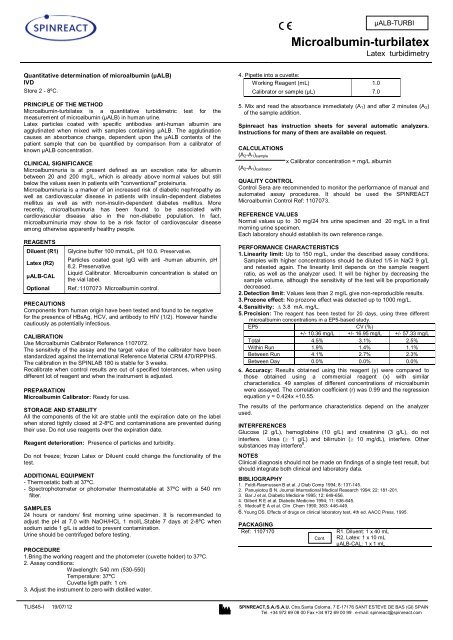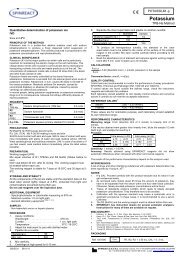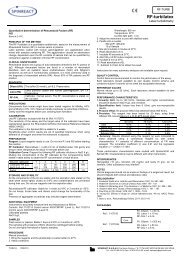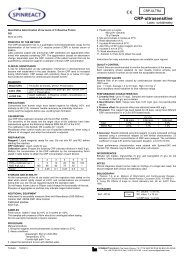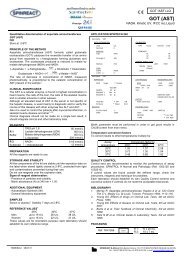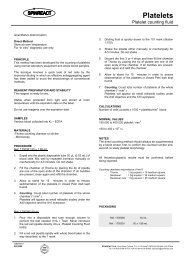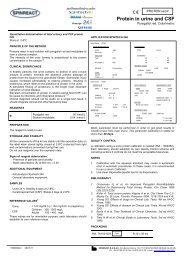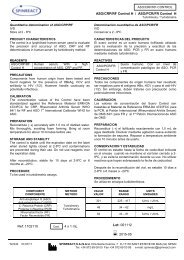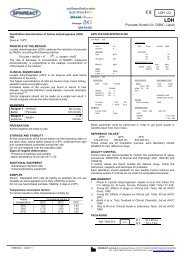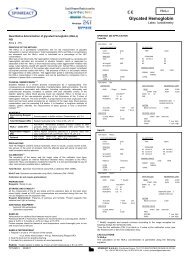Microalbumin-turbilatex
Microalbumin-turbilatex - Spinreact
Microalbumin-turbilatex - Spinreact
You also want an ePaper? Increase the reach of your titles
YUMPU automatically turns print PDFs into web optimized ePapers that Google loves.
µALB-TURBI<br />
<strong>Microalbumin</strong>-<strong>turbilatex</strong><br />
Latex turbidimetry<br />
Quantitative determination of microalbumin (µALB)<br />
IVD<br />
Store 2 - 8ºC.<br />
PRINCIPLE OF THE METHOD<br />
<strong>Microalbumin</strong>-<strong>turbilatex</strong> is a quantitative turbidimetric test for the<br />
measurement of microalbumin (µALB) in human urine.<br />
Latex particles coated with specific antibodies anti-human albumin are<br />
agglutinated when mixed with samples containing µALB. The agglutination<br />
causes an absorbance change, dependent upon the µALB contents of the<br />
patient sample that can be quantified by comparison from a calibrator of<br />
known µALB concentration.<br />
CLINICAL SIGNIFICANCE<br />
<strong>Microalbumin</strong>uria is at present defined as an excretion rate for albumin<br />
between 20 and 200 mg/L, which is already above normal values but still<br />
below the values seen in patients with "conventional" proteinuria.<br />
<strong>Microalbumin</strong>uria is a marker of an increased risk of diabetic nephropathy as<br />
well as cardiovascular disease in patients with insulin-dependent diabetes<br />
mellitus as well as with non-insulin-dependent diabetes mellitus. More<br />
recently, microalbuminuria has been found to be associated with<br />
cardiovascular disease also in the non-diabetic population. In fact,<br />
microalbuminuria may show to be a risk factor of cardiovascular disease<br />
among otherwise apparently healthy people.<br />
REAGENTS<br />
Diluent (R1)<br />
Latex (R2)<br />
µALB-CAL<br />
Optional<br />
Glycine buffer 100 mmol/L, pH 10.0. Preservative.<br />
Particles coated goat IgG with anti -human albumin, pH<br />
8.2. Preservative.<br />
Liquid Calibrator. <strong>Microalbumin</strong> concentration is stated on<br />
the vial label.<br />
Ref.:1107073 <strong>Microalbumin</strong> control.<br />
PRECAUTIONS<br />
Components from human origin have been tested and found to be negative<br />
for the presence of HBsAg, HCV, and antibody to HIV (1/2). However handle<br />
cautiously as potentially infectious.<br />
CALIBRATION<br />
Use <strong>Microalbumin</strong> Calibrator Reference 1107072.<br />
The sensitivity of the assay and the target value of the calibrator have been<br />
standardized against the International Reference Material CRM 470/RPPHS.<br />
The calibration in the SPINLAB 180 is stable for 3 weeks.<br />
Recalibrate when control results are out of specified tolerances, when using<br />
different lot of reagent and when the instrument is adjusted.<br />
PREPARATION<br />
<strong>Microalbumin</strong> Calibrator: Ready for use.<br />
STORAGE AND STABILITY<br />
All the components of the kit are stable until the expiration date on the label<br />
when stored tightly closed at 2-8ºC and contaminations are prevented during<br />
their use. Do not use reagents over the expiration date.<br />
Reagent deterioration: Presence of particles and turbidity.<br />
Do not freeze; frozen Latex or Diluent could change the functionality of the<br />
test.<br />
ADDITIONAL EQUIPMENT<br />
- Thermostatic bath at 37ºC.<br />
- Spectrophotometer or photometer thermostatable at 37ºC with a 540 nm<br />
filter.<br />
SAMPLES<br />
24 hours or random/ first morning urine specimen. It is recommended to<br />
adjust the pH at 7.0 with NaOH/HCL 1 mol/L.Stable 7 days at 2-8ºC when<br />
sodium azide 1 g/L is added to prevent contamination.<br />
Urine should be centrifuged before testing.<br />
PROCEDURE<br />
1.Bring the working reagent and the photometer (cuvette holder) to 37ºC.<br />
2. Assay conditions:<br />
Wavelength: 540 nm (530-550)<br />
Temperature: 37ºC<br />
Cuvette ligth path: 1 cm<br />
3. Adjust the instrument to zero with distilled water.<br />
4. Pipette into a cuvette:<br />
Working Reagent (mL) 1.0<br />
Calibrator or sample (µL) 7.0<br />
5. Mix and read the absorbance immediately (A 1) and after 2 minutes (A 2)<br />
of the sample addition.<br />
Spinreact has instruction sheets for several automatic analyzers.<br />
Instructions for many of them are available on request.<br />
CALCULATIONS<br />
(A 2-A 1) sample<br />
(A 2-A 1) calibrator<br />
x Calibrator concentration = mg/L albumin<br />
QUALITY CONTROL<br />
Control Sera are recommended to monitor the performance of manual and<br />
automated assay procedures. It should be used the SPINREACT<br />
<strong>Microalbumin</strong> Control Ref: 1107073.<br />
REFERENCE VALUES<br />
Normal values up to 30 mg/24 hrs urine specimen and 20 mg/L in a first<br />
morning urine specimen.<br />
Each laboratory should establish its own reference range.<br />
PERFORMANCE CHARACTERISTICS<br />
1. Linearity limit: Up to 150 mg/L, under the described assay conditions.<br />
Samples with higher concentrations should be diluted 1/5 in NaCl 9 g/L<br />
and retested again. The linearity limit depends on the sample reagent<br />
ratio, as well as the analyzer used. It will be higher by decreasing the<br />
sample volume, although the sensitivity of the test will be proportionally<br />
decreased.<br />
2. Detection limit: Values less than 2 mg/L give non-reproducible results.<br />
3. Prozone effect: No prozone effect was detected up to 1000 mg/L.<br />
4. Sensitivity: 3.8 mA. mg/L.<br />
5. Precision: The reagent has been tested for 20 days, using three different<br />
microalbumin concentrations in a EP5-based study.<br />
EP5 CV (%)<br />
+/- 10.36 mg/L +/- 16.95 mg/L +/- 57.33 mg/L<br />
Total 4.5% 3.1% 2.5%<br />
Within Run 1.9% 1.4% 1.1%<br />
Between Run 4.1% 2.7% 2.3%<br />
Between Day 0.0% 0.0% 0.0%<br />
6. Accuracy: Results obtained using this reagent (y) were compared to<br />
those obtained using a commercial reagent (x) with similar<br />
characteristics. 49 samples of different concentrations of microalbumin<br />
were assayed. The correlation coefficient (r) was 0.99 and the regression<br />
equation y = 0.424x +10.55.<br />
The results of the performance characteristics depend on the analyzer<br />
used.<br />
INTERFERENCES<br />
Glucose (2 g/L), hemoglobine (10 g/L) and creatinine (3 g/L), do not<br />
interfere. Urea ( 1 g/L) and bilirrubin ( 10 mg/dL), interfere. Other<br />
substances may interfere 6 .<br />
NOTES<br />
Clinical diagnosis should not be made on findings of a single test result, but<br />
should integrate both clinical and laboratory data.<br />
BIBLIOGRAPHY<br />
1. Feldt-Rasmussen B et al. J Diab Comp 1994; 8: 137-145.<br />
2. Panuyiotou B N. Journal International Medical Research 1994; 22: 181-201.<br />
3. Bar J et al. Diabetic Medicine 1995; 12: 649-656.<br />
4. Gilbert R E et al. Diabetic Medicine 1994; 11: 636-645.<br />
5. Medcalf E A et al. Clin Chem 1990; 36/3: 446-449.<br />
6. Young DS. Effects of drugs on clinical laboratory test, 4th ed. AACC Press, 1995.<br />
PACKAGING<br />
Ref: 1107170<br />
Cont.<br />
R1. Diluent: 1 x 40 mL<br />
R2. Latex: 1 x 10 mL<br />
µALB-CAL: 1 x 1 mL<br />
TLIS45-I 19/07/12 SPINREACT,S.A./S.A.U. Ctra.Santa Coloma, 7 E-17176 SANT ESTEVE DE BAS (GI) SPAIN<br />
Tel. +34 972 69 08 00 Fax +34 972 69 00 99 e-mail: spinreact@spinreact.com
µALB-TURBI<br />
Microalbúmina-turbilátex<br />
Turbidimetría Látex<br />
Determinación cuantitativa de la microalbúmina (µALB)<br />
IVD<br />
Conservar a 2 - 8ºC.<br />
PRINCIPIO DEL MÉTODO<br />
La microalbúmina-turbilátex es un ensayo turbidimétrico para la cuantificación de<br />
microalbúmina (µALB) en orina humana.<br />
Las partículas de látex recubiertas con anticuerpos anti-albúmina humana, son<br />
aglutinadas por µALB presente en la muestra del paciente. El proceso de<br />
aglutinación provoca un cambio de absorbancia proporcional a la concentración de<br />
µALB de la muestra, y por comparación con un calibrador de µALB de<br />
concentración conocida se puede determinar el contenido de µALB en la muestra<br />
ensayada.<br />
SIGNIFICADO CLÍNICO<br />
Se define la microalbuminúria como la tasa de excreción de albúmina en orina entre<br />
20 y 200 mg/l, concentración que, siendo superior al valor normal, está aun por<br />
debajo de la concentración considerada como una proteinúria convencional.<br />
La microalbuminúria es un marcador del riesgo de la nefropatía diabética, así como<br />
de alteraciones cardiovasculares en pacientes que sufren diabetes mellitus insulinadependientes<br />
o bien insulina no-dependientes. Recientemente, se ha observado<br />
que la microalbuminuria también está asociada a enfermedades cardiovasculares<br />
en poblaciones no diabéticas y normales.<br />
REACTIVOS<br />
Diluyente (R1)<br />
Látex (R2)<br />
µALB-CAL<br />
Opcional<br />
Tampón glicina 100 mmol/L, pH 10,0. Conservante.<br />
Partículas de látex cubiertas de IgG de cabra anti-albúmina<br />
humana, pH, 8,2. Conservante.<br />
Calibrador líquido. La concentración de microalbúmina viene<br />
indicada en la etiqueta del vial.<br />
Ref: 1107073 Control de microalbúmina.<br />
PRECAUCIONES<br />
Todos los componentes de origen humano han resultado ser negativos para el<br />
antígeno HBs, HCV y para el anti-HIV (1/2). Sin embargo, deben tratarse con<br />
precaución como potencialmente infecciosos.<br />
CALIBRACIÓN<br />
Usar el Calibrador de Microalbúmina Referencia 1107072.<br />
La sensibilidad del ensayo y el valor de concentración del Calibrador están<br />
estandarizados frente al Material de Referencia Internacional CRM 470/RPPHS.<br />
La calibración en el SPINLAB 180 es estable durante 3 semanas.<br />
Recalibrar cuando los resultados del control están fuera de especificaciones,<br />
cuando se usa diferente lote de reactivo y cuando se ajusta el instrumento.<br />
PREPARACIÓN<br />
Calibrador de Microalbúmina: Listo para su uso.<br />
CONSERVACIÓN Y ESTABILIDAD<br />
Todos los componentes del kit son estables hasta la fecha de caducidad indicada<br />
en el envase cuando se mantienen los viales bien cerrados a 2-8ºC, y se evita la<br />
contaminación durante su uso. No utilizar reactivos que hayan sobrepasado la<br />
fecha de caducidad.<br />
Indicadores de deterioro de los reactivos: Presencia de partículas y turbidez.<br />
La congelación de los reactivos de Látex y Diluyente altera irreversiblemente la<br />
funcionalidad de los mismos.<br />
MATERIAL ADICIONAL<br />
- Baño de agua a 37ºC.<br />
- Espectrofotómetro o fotómetro con cubeta termostatizable a 37ºC. para lecturas a<br />
540 nm.<br />
MUESTRAS<br />
Orina de 24 hrs o muestra aleatoria/ orina de primera hora de la mañana. Se<br />
recomienda ajustar el pH a 7,0 con NaOH/HCl 1 mol/L. Estable 7 días a 2-8ºC<br />
cuando se le añade azida sódica 1 g/L para prevenir posibles contaminaciones.<br />
Centrifugar la orina antes de ensayar.<br />
PROCEDIMIENTO<br />
1. Calentar el Reactivo de Trabajo y el fotómetro (portacubetas) a 37ºC.<br />
2. Condiciones del ensayo:<br />
Longitud de onda: 540 nm (530 – 550)<br />
Temperatura: 37ºC<br />
Paso de luz de la cubeta: 1 cm<br />
3. Ajustar el espectrofotómetro a cero frente a agua destilada.<br />
4. Pipetear en una cubeta:<br />
Reactivo de Trabajo (mL) 1,0<br />
Calibrador o muestra (µL) 7,0<br />
5. Mezclar y leer la absorbancia frente al blanco inmediatamente (A 1) y a los 2<br />
minutos (A 2) de efectuada la mezcla.<br />
Spinreact dispone de adaptaciones detalladas a la mayoría de analizadores<br />
automáticos del mercado. Solicite la información a su distribuidor.<br />
CALCULOS<br />
(A 2-A 1) muestra<br />
(A 2-A 1) Calibrador<br />
x Concentración del Calibrador = mg/L albúmina<br />
CONTROL DE CALIDAD<br />
Se recomienda utilizar controles para controlar los ensayos tanto en<br />
procedimiento manual como en automático. Debe usarse el control de<br />
SPINREACT de Microalbúmina Ref.: 1107073.<br />
Cada laboratorio debería establecer su propio Control de Calidad y establecer<br />
correcciones en el caso de que los controles no cumplan con las tolerancias<br />
exigidas.<br />
VALORES DE REFERENCIA<br />
Valores normales hasta 30 mg en muestra de orina de 24 hrs y 20 mg/L en<br />
muestra de orina de primera hora de la mañana.<br />
Es recomendable que cada laboratorio establezca sus propios valores de<br />
referencia.<br />
CARACTERÍSTICAS DEL MÉTODO<br />
1. Límite de linealidad: hasta 150 mg/L, en las condiciones descritas del<br />
ensayo. Puede variar en función del analizador o espectrofotómetro utilizado.<br />
La linealidad depende de la relación muestra/reactivo. Muestras con valores<br />
superiores deben diluirse 1/5 en ClNa 9 g/L y ensayarse de nuevo.<br />
Disminuyendo el volumen de muestra, se aumenta el límite superior de<br />
linealidad, aunque se reduce la sensibilidad.<br />
2. Límite de detección: Valores por debajo de 2 mg/L dan lugar a resultados<br />
poco reproducibles.<br />
3. Efecto prozona: No se observa efecto prozona hasta valores de 1000 mg/L.<br />
4. Sensibilidad: 3,8 mA. mg/L.<br />
5. Precisión: El reactivo ha sido probado durante 20 días con tres<br />
concentraciones diferentes de microalbúmina en un estudio basado en las<br />
normas EP5 (NCCLS).<br />
EP5 CV (%)<br />
+/- 10.36 mg/L +/- 16.95 mg/L +/- 57.33 mg/L<br />
Total 4.5% 3.1% 2.5%<br />
Within Run 1.9% 1.4% 1.1%<br />
Between Run 4.1% 2.7% 2.3%<br />
Between Day 0.0% 0.0% 0.0%<br />
6. Exactitud: El comportamiento de este método (y) fue comparado con otro<br />
método (x) de características similares. 49 muestras de diferentes<br />
concentraciones de microalbúmina fueron analizadas con ambos métodos. El<br />
coeficiente de regresión (r) fue de 0,99 y la ecuación de la recta de regresión<br />
y = 0.424x +10.55.<br />
Las características del método pueden variar según el analizador utilizado.<br />
INTERFERENCIAS<br />
Glucosa (2 g/L), hemoglobina (10 g/L) y creatinina (3 g/L), no interfieren.<br />
Urea ( 1 g/L) y bilirrubina ( 10 mg/dL), interfieren. Otras sustancias pueden<br />
interferir 6 .<br />
NOTAS<br />
El diagnóstico clínico no debe realizarse únicamente con los resultados de un<br />
único ensayo, sino que debe considerarse al mismo tiempo los datos clínicos del<br />
paciente.<br />
BIBLIOGRAFÍA<br />
1. Feldt-Rasmussen B et al. J Diab Comp 1994; 8: 137-145.<br />
2. Panuyiotou B N. Journal International Medical Research 1994; 22: 181-201.<br />
3. Bar J et al. Diabetic Medicine 1995; 12: 649-656.<br />
4. Gilbert R E et al. Diabetic Medicine 199;: 11: 636-645.<br />
5. Medcalf E A et al. Clin Chem 1990; 36/3: 446-449.<br />
6. Young DS. Effects of drugs on clinical laboratory test, 4th ed. AACC Press,<br />
1995.<br />
PRESENTACIÓN<br />
Ref.: 1107170<br />
Cont.<br />
R1. Diluyente:1 x 40 mL<br />
R2. Látex:1 x 10 mL<br />
µALB-CAL:1 x 1 mL<br />
TLIS45-E 19/07/12 SPINREACT,S.A./S.A.U. Ctra.Santa Coloma, 7 E-17176 SANT ESTEVE DE BAS (GI) SPAIN<br />
Tel. +34 972 69 08 00 Fax +34 972 69 00 99 e-mail: spinreact@spinreact.com


